
Dodonaea is a genus of about 70 species of flowering plants, often known as hop-bushes, in the soapberry family, Sapindaceae. It has a cosmopolitan distribution in tropical, subtropical and warm temperate regions of Africa, the Americas, southern Asia and Australasia. By far the highest species diversity is in Australia. The genus is named after Rembert Dodoens, traditionally known as 'Dodonaeus'.

Harpullia is a genus of about 27 species of small to medium-sized rainforest trees from the family Sapindaceae. They have a wide distribution ranging from India eastwards through Malesia, Papuasia and Australasia to the Pacific Islands. They grow naturally usually in or on the margins of rainforests or associated vegetation.
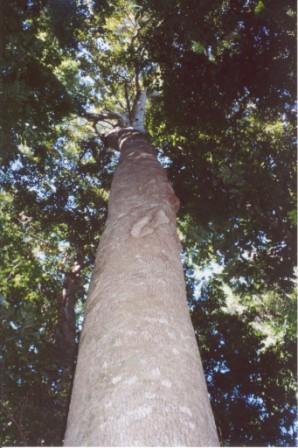
Gmelina leichhardtii, the white beech, is a tree of eastern Australia. Scattered individuals or small groups of trees naturally occur from the Illawarra district of New South Wales to near Proserpine in tropical Queensland. The white beech or grey teak is a fast-growing tree, growing on volcanic and alluvial soils in areas of moderate to high rainfall. It also grows on poorer sedimentary soils in fire free areas. White beech may occasionally be seen in Australian rainforests, though their status is considered "uncommon". Unlike the Australian red cedar, the white beech has not recovered particularly well after logging in the 19th and 20th centuries.

Melicope elleryana, commonly known as pink flowered doughwood, pink evodia, corkwood, or saruwa, is a species of rainforest shrub or tree in the family Rutaceae, and is native to New Guinea, parts of eastern Indonesia, the Solomon Islands and northern Australia. It has trifoliate leaves and pink to white, bisexual flowers arranged in panicles in leaf axils.

Harpullia hillii, commonly known as blunt-leaved tulip or oblong-leaved tulip, is a tree in the family Sapindaceae, endemic to eastern Australia. Although the species may grow to 20 metres high, most trees are less than 10 metres high. Each leaf comprises 4 to 12 leaflets, that are oblong or elliptic oblong and between 5 and 15 cm long and 2 to 6 cm wide. White flowers with petals 10–12 mm long appear in panicles that are 10–25 cm long. These are followed by orange fruit that are 25–30 mm in diameter and 12–14 mm long. The fruit, which is positioned above the persistent sepals, becomes woody with age. The glossy black seeds protrude from red arils.
Lepidopetalum is a genus of six species of trees known to science, constituting part of the plant family Sapindaceae.

Atkinsonia is a hemi-parasitic shrub with oppositely set, entire leaves and yellowish, later rusty-red colored flowers, that is found in Eastern Australia. It is a monotypic genus, the only species being Atkinsonia ligustrina, and is assigned to the showy mistletoe family, Loranthaceae. It is sometimes called Louisa's mistletoe.
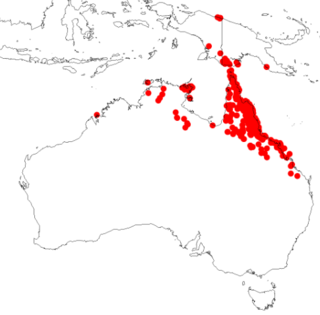
Acacia simsii is a shrub belonging to the genus Acacia in the family Fabaceae. It is native to New Guinea and northern Australia. In Australia it is found in both the Northern Territory and Queensland.

Acacia leichhardtii, commonly known as Leichhardt's wattle, is a shrub of the genus Acacia and the subgenus Phyllodineae that is endemic to north eastern Australia.
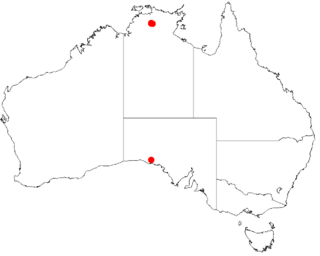
Acacia amanda is a shrub in the genus Acacia that is native to Northern Territory.

Acacia latzii, also known as Latz's wattle and Tjilpi wattle, is a shrubby tree of the genus Acacia. It is native to the Finke bioregion.
Polygala bifoliata is a species of flowering plant in the milkwort family (Polygalaceae), which was first described in 2012 by Raelee Kerrigan. It is endemic to the Northern Territory and Western Australia.

Scaevola parvifolia is an erect, many stemmed perennial in the family Goodeniaceae, which is native to Western Australia, the Northern Territory, Queensland and South Australia. It grows to a height of 0.6 m, and its blue-purple flowers may be seen from March to October.

Tribulus platypterus, the cork hopbush, is a species of flowering plant in the family Zygophyllaceae, which is endemic to the northwest of Western Australia. It is closely related to Tribulus suberosus.
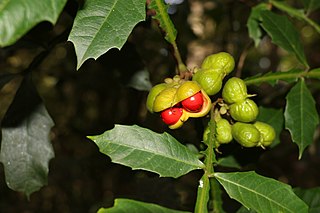
Harpullia alata, common name -winged tulip or wing-leaved tulip, is a tree in the family Sapindaceae, endemic to eastern Australia, and found from Brisbane, Queensland to Grafton, New South Wales.

Harpullia cupanioides is a plant in the Sapindaceae family found in south east Asia: in the Andaman Islands, Assam, Bangladesh, Borneo, Cambodia, Yunnan, Hainan, Jawa, Laos, the Lesser Sunda Islands, Malaysia, Myanmar, New Guinea, Nicobar Islands, the Philippines, the Solomon Islands, Thailand, and Vietnam.

Coopernookia strophiolata is a shrub in the Goodeniaceae family, endemic to Australia and found in both Western Australia and South Australia.
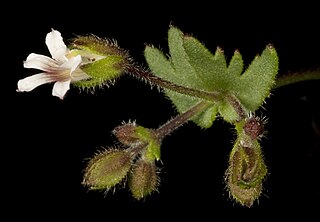
Goodenia cycnopotamica is a plant in the Goodeniaceae family which is endemic to Australia, and found in both South Australia and Western Australia

Acacia subporosa, also commonly known as river wattle, bower wattle, narrow-leaf bower wattle and sticky bower wattle, is a tree or shrub of the genus Acacia and the subgenus Plurinerves that is endemic to an area of south eastern Australia. It is considered to be rare in Victoria

Harpullia ramiflora, commonly known as the Claudie tulipwood or Cape York tulipwood, is a tree in the Sapindaceae family native to north east Queensland, New Guinea and parts of Malesia.


















